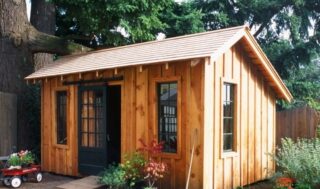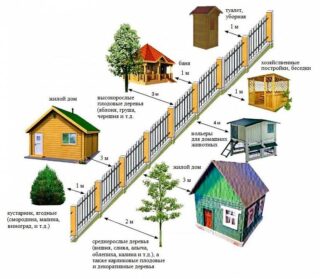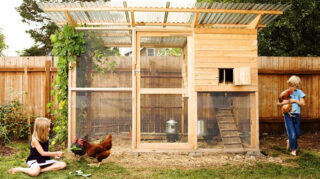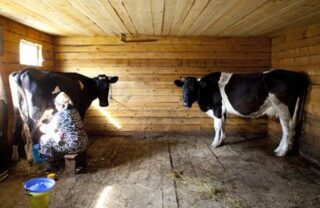A plot is a limited plot of land on which you need to place a lot of objects. The difficulty lies in the fact that the distance between them is regulated by many rules: the distance between the fence and the barn, the distance from the toilet to the house, the height of green spaces and many other factors.
- Modern standards
- Legislative regulations
- Fire safety standards
- Standards within the site
- Sanitary construction standards
- Things to Consider
- The height of the fence in front of the neighbor's windows
- Distance from the building to the fence in front of the neighbor's windows
- Distance from the chicken coop to the border of the neighboring site
- Distance from the red line of the road to the house
- Outbuilding next to an empty lot
- Green spaces, fruit and ornamental trees
- Existing nuances and possibilities of discrepancy
Modern standards

Building rules, including the distance between objects, are regulated by the DBN "Planning and development of territories". The rules are slightly different for parcels of different sizes. At the same time, the type - IZhS, DPN - does not really matter for small allotments, but it limits the type of occupation. It is forbidden to breed cattle on IZHS, therefore it is impossible to build a barn-barn.
Legislative regulations
The number of buildings on the site is limited. The main rule of development says: the total area of buildings and sheds is no more than 30% of the total area of the cottage. At the same time, the minimum allotment area is 500 m². With a smaller area, building is prohibited.
The standards regulate not only the location of objects on the territory, but also take into account the placement of buildings with neighbors. If they are already built up, the owner will have to study the plan of the adjacent plot to determine the location for his house, shed or garage.
First of all, they determine how much it is required to retreat from the boundary, fence and street:
- 3 m - the minimum distance from the wall to the fence;
- if the neighboring site is built up, the distance is reduced to 1 m, but it is calculated not from the walls, but from protruding parts - the overhang of the roof, for example;
- from the center of the street in the village or highway to the building on the territory must be at least 6 m;
- the distance from the usual street is 3 m.
Before building the site, you need to obtain a permit and notify the local administration about construction work.
Fire safety standards
The rules are as follows:
- 6 m recede between brick and stone sheds;
- if the building is stone, but with a wooden floor or roof, the distance is increased to 8 m;
- a distance of 10 m is left between the stone building and the wooden shed;
- the distance between 2 wooden buildings of any kind is 15 m.
The indicated distances are observed not only between buildings on the site, but also between similar objects on two plots.
Standards within the site

The allotment houses objects of various purposes: a dwelling house, a shed for garden tools, a toilet, a bathhouse, a well, a well, a poultry house, a compost pit. Each object has its own norms:
- you should retreat from the fence when constructing a shed by 1 m. This is the minimum for any non-residential buildings;
- if a shed is built for animals, the distance increases to 4 m;
- utility block from the building is located 3 m;
- a poultry house or a shed for rabbits - no closer than 12 m;
- the shed is 5 m away from the center of the carriageway;
- the distance between the foundation and the water supply is kept within 3 m.
The exception is residential complexes with an attached utility block. The latter can be a poultry house and even a barn. In this case, 2 different entrances are made at a distance of 7 m.
Sanitary construction standards
When building an allotment, it is important to comply with sanitary and hygienic standards. If the tool box has no effect on the environment, the house is a source of contamination.
The norms are as follows:
- Outdoor shower, toilet, bathhouse are 8 m away from the house.
- A compost pit is placed at the same distance.
- A poultry house or a pig barn has the same effect as a septic tank, so that buildings are removed from the residential building by 12 m.
- The most important thing is to maintain the distance to the well. Groundwater or rainwater contaminated with bird droppings, falling into the well, poison the water. So such objects are removed from the well or well at a distance of 8 m.
It is necessary to take into account the distance to similar objects on the neighboring allotment.
Things to Consider
In addition to sanitary standards or fire safety requirements, there are other restrictions related to the height of the objects on the site.
The height of the fence in front of the neighbor's windows

The height of the fence is determined by its design and the regulations in force in the region:
- A mesh fence or a translucent lattice, can reach a height of 1.5 m.
- A blank wall cannot exceed 70 cm. However, it is allowed to conclude an agreement with a neighbor and build a higher fence.
- It is possible to build up a solid brick fence with a translucent structure up to a height of 1.5 m.
- The green shrub barrier belongs to translucent structures and can reach a height of 1.5 m.
The essence of the prohibitions on the height of the fence is related to the requirements for insolation. If a fence that is too high blocks the sun and the house on a neighboring plot is not sufficiently illuminated, this is a violation.
In different regions, the height of a blind fence can reach 1.5 m, and a lattice fence - 2.2 m.
Distance from the building to the fence in front of the neighbor's windows
By law, a barn is built from a neighbor's fence at a distance of 1 m. There are unpleasant nuances here. SNiP does not give an intelligible wording regulating the height of the outbuilding. The height of a residential building is limited, but if the building is recognized as non-residential - a bathing guest complex, which is used twice a week - this requirement does not apply to it.
In fact, a 6-meter relatively non-residential building with windows obscures the sun in the neighboring territory, which contradicts the requirements for insolation. The issue remains controversial and often serves as a reason for going to court.
Distance from the chicken coop to the border of the neighboring site

It is allowed to breed small ruminants and poultry in the dachas. The norm for a chicken coop is 4 m distance from the fence. In fact, it depends on the number of birds. If we are talking about 10 individuals, this is enough. If the owner decided to start a mini-farm, such a small distance will not save neighbors from noise, smell, pollution.
As a rule, such a farm violates sanitary standards, which allows neighbors to file complaints with the local administration and the court.
Distance from the red line of the road to the house
The red line delineates the boundaries of the public area. You should take into account the following nuance: if a road is outlined with a red line, the space around 2 m on each side is also a part of this zone. If a private plot is adjacent to a road, the construction company has the right to build a bus stop right on the land of the summer resident.
When building up from the red line, you need to retreat at least 5 m.
Outbuilding next to an empty lot
A shed is built in any convenient place at a distance of 1 m from the future fence. If the adjacent plot is empty, but planted with a garden, the height of the trees is taken into account.
Green spaces, fruit and ornamental trees
The distance depends on the height of the plants.A shed is erected at a distance of 4 m from tall trees, and 2 m from medium-sized ones. Bushes can be planted at a distance of 1 m from the building wall. The same goes for plants on a neighboring plot.
Existing nuances and possibilities of discrepancy

At what distance from the fence and other objects a barn can be erected depends on other factors.
The barn or poultry house is a source of pollution. The building is removed from the fence by 4 m, from the residential building - by 10 m. The shed is placed at a distance of 15 m to the well or other source of water, so as not to poison the water.
At the same time, the distance to objects such as a compost pit, a toilet, a cesspool is reduced to 1 m.Also, a shed for a barn or a chicken coop can be placed at a distance of 1 m or a common enclosure can be built, but with separate doors at a distance of 1 m ...
A shed is allowed to be attached to the house. Even a cowshed may be added if the entrance to it is separate and located at a distance of 7 m.However, this is possible only on the sites of SNT or DNA, if the local administration permits the breeding of cows and sheep. Breeding of cattle is prohibited on the IZhS site.
In a small area of 5–6 acres, it is very difficult to place all objects in such a way as to comply with all the rules, especially in relation to the neighboring plot, but we are more undeveloped. It is better to overcome the temptation and conclude an agreement with a neighbor. In such an agreement, they indicate exactly where the barn will be located and confirm that construction is being carried out with the consent of both parties. In this case, the change house can be placed directly on the border: the back wall of the shed serves as part of the fence. The poultry house is not located at a distance, but next to the fence.
The agreement on deviation from the norms becomes invalid when the owner of both one and the second plot is changed.
A building permit is required if the building is capital: with a foundation, brick or stone walls. A light metal change house is not. You don't need permission for it. Moreover, construction norms do not apply to it.










I bought a dacha with a brick house. The house is 40 years old, strong and reliable. But they are not registered in the register, tk. half a meter from the fence. Should he be demolished or what? And on what shisha new to build? Behind the fence FOREST !!!! Two meters later. Rather, abandoned areas overgrown with forest. Who came up with these idiotic standards? Who can get in the way of a brick wall? Old wooden houses stand right next to the sidewalk, should they be evicted? Where to? A mortgage?